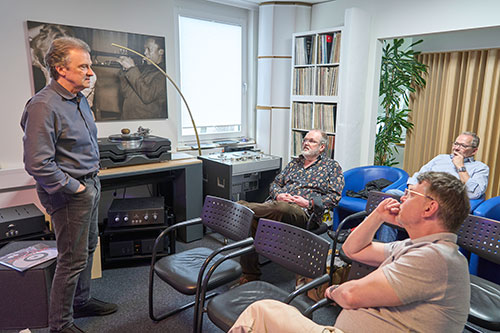
Since production of the racks is made to order, Finite Elemente can also respond to special requests: For a customer in India, for example, a rack was built to match the colour of the loudspeakers of a complete Burmester system, Luis Fernandes revealed. At the moment, Finite Elemente has 25 distributors and is represented in 30 countries. Pagode racks accounted for about 70 per cent of sales, Cera feet for 20 per cent and Carbofibre° HD platforms for 10 per cent. Finite Elemente purchases the Cera products completely packed from a manufacturer just 30 kilometres away. However, the manufacturer is supplied with pre-packed bags of accessories, the contents of which are put together in Meschede when no major orders are pending and there would otherwise be a risk of idle time. For example, M6/M8 thread adapters are enclosed with the Cerabase.

Despite all the innovations and different versions, the most important construction features of the racks have remained the same: On the one hand, the upper frames and the bottom frame, which is screwed to the side pillars, are made of solid Canadian maple that has been stored and dried for a longer period of time. Luis Fernandes chose this type of wood because it has a lot of sustain and is in no way overdamped. The frame is topped by an inserted shelf, which in the first version consisted of two layers of MDF with damping material in between and was then veneered or lacquered. From today's perspective, the developer describes these shelves as overdamped. In the current MKII version, the shelves consist of a honeycomb structure that is veneered all around or, in the Carbofibre° version, surrounded by carbon fibre plates. Initially, spikes provided the coupling of the shelf to the frame. In the current version, ceramic balls mounted in metal bolts take over this task. The frames are still connected to the metal side pillars on the right and left by four so-called side spikes each, and for about 20 years proprietarily designed Resonators specially tuned to the number and size of the component levels have ensured that the most pronounced resonances are converted into heat. Luis Fernandes developed this technology in cooperation with the Dortmund University of Applied Sciences and Arts. Further information can be found here. The bottom level, which is screwed to the side pillars, then rests on stainless steel spikes with integrated floor protection plates or Cerabase, depending on the model.

-
STATEMENT in High Fidelity | German Edition 2025
Während der High End 2025 in München wurden die STATEMENT in High Fidelity-Auszeichnungen verliehen und zwar wie immer am Morgen des ersten Messetages. Am darauffolgenden Abend waren die Gewinner dann zum Dinner in eine bayrisches Gasthaus eingeladen. Darüber zu berichten obliegt traditionell meinem Kollegen Wojciech Pacuła Zur Erinnerung: Diesmal wurden von hifistatement.net und highfidelity.pl der Audio-Dateitransport Taiko Audio Olympus XDMI + I/O XDMI und die Lautsprecher Stenheim Alumine Five SX ausgezeichnet. Auf den ersten Blick…06.06.2025 -
Statements in High Fidelity | German Edition 2025
The magazine of my colleague Wojciech Pacuła, highfidelity.pl, and hifistatement.net traditionally award a component at the trade fairs in Munich and Warsaw that impressed us in the previous six months. When the High End will take place in Vienna next year, will we still be able to talk about a German Edition? There will probably have to be some changes to the awards next year, but there are also two novelties this year: My colleague…13.05.2025 -
Statements in High Fidelity | German Edition 2025
Das Magazin meines Kollegen Wojciech Pacuła, highfidelity.pl, und hifistatement.net zeichnen zu den Messen in München und in Warschau traditionell jeweils eine Komponente aus, die uns im vorausgegangenen Halbjahr begeisterte. Wenn die High End nächstes Jahr in Wien stattfindet, werden wir dann immer noch von einer German Edition sprechen können? Bei den Awards wird sich im kommenden Jahr wohl einiges ändern müssen, aber auch heuer gibt es zwei Neuerungen: Der Kollege pflegte mit großer Beharrlichkeit CD-Player…13.05.2025 -
Acoustical Systems Analog Workshop
Kürzlich veranstaltete Acoustic Systems in Person von Axinia Schäfer, die für die Leitung der Firma verantwortlich zeichnet, und Dietrich Brakemeier, dem die technische Entwicklung der Analogkomponenten obliegt, in den Firmenräumen in Hofstetten den 1. Audiophilen Analog Workshop. Der dauerte zwei Tage und endete mit einen Klavier-Solo-Konzert. Auch wenn andere Termine die Teilnahme am Sonntag unmöglich machten, konnte ich mir den Besuch der absoluten High-End-Analog-Schmiede natürlich nicht entgehen lassen, zumal in der Einladung von einem „lockeren…02.05.2025 -
Ein Besuch bei Unison Research und Opera
Nachdem Ihnen Carsten Bussler über seine sehr positiven Erfahrungen mit Unison Researchs Simply Italy Black Edition berichtete, kann ich hier noch einiges zu den daran beteiligten Personen und ihrem Anspruch, aber auch zur Geschichte der Firma nachtragen, schließlich wurde sie schon vor 36 Jahren gegründet und zwar von Giovanni Maria Sacchetti. Ganz so lange kenne ich die Marke zwar noch nicht, aber ich bin ihr bei einem Pressetermin in Venedig erstmals begegnet, als die imposanten…28.04.2025 -
Andante-Largo-Chef Suzuki san zu Besuch
Mika Dauphins Drei H Vertrieb hat eine neue Marke in sein Portfolio aufgenommen: Andante Largo mit seinen Racks, Spike-Aufnahmen und einem Kontaktverbesserer. Wie könnte man die Produkte besser kennenlernen als bei einem Besuch von Inhaber Suzuki san und seinem Sales Manager Kai Endo im heimischen Hörraum? An einem Freitagabend schaute Thomas Heckel, der Drei H in Süddeutschland vertritt, in Gröbenzell vorbei und stellte mir die beiden Japaner vor. Das Trio hatte auch jede Menge Taschen…07.03.2025
© 2025 | HIFISTATEMENT | netmagazine | Alle Rechte vorbehalten | Impressum | Datenschutz























 |
|

































































































